Human Resource Management Report: GE Case Study Analysis
VerifiedAdded on 2023/06/08
|12
|3407
|247
Report
AI Summary
This report delves into the core concepts of Human Resource Management (HRM), focusing on organizational design, employee motivation, and the development of a skilled workforce. The report uses General Electric (GE) as a case study to illustrate the application of these principles. It evaluates the significance of organizational design theory in aligning organizational structure with strategic goals, examining the importance of company culture, leadership, future growth and adaptability. It also analyzes various approaches and techniques used in HRM, including different motivational strategies (stick, carrot, and combined approaches) and human capital development through training, mentoring, and attracting quality talent. Furthermore, the report explores contemporary knowledge and research in HRM departments, highlighting the use of artificial intelligence in recruitment, the impact of data analytics, and continuous performance management. The analysis provides recommendations for GE to optimize its HRM practices, emphasizing the importance of a combined motivational approach and investing in employee development to foster a productive and skilled workforce.
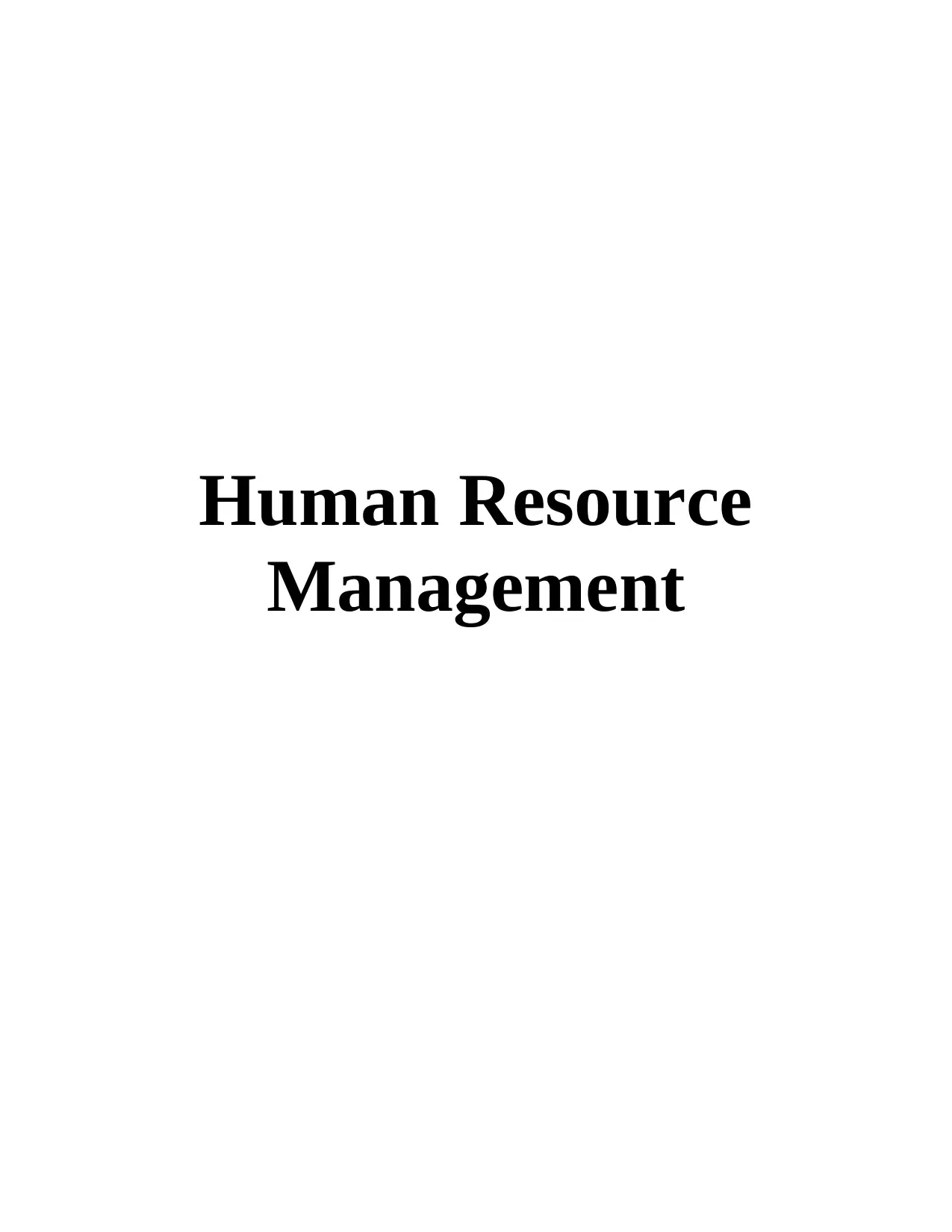
Human Resource
Management
Management
Paraphrase This Document
Need a fresh take? Get an instant paraphrase of this document with our AI Paraphraser
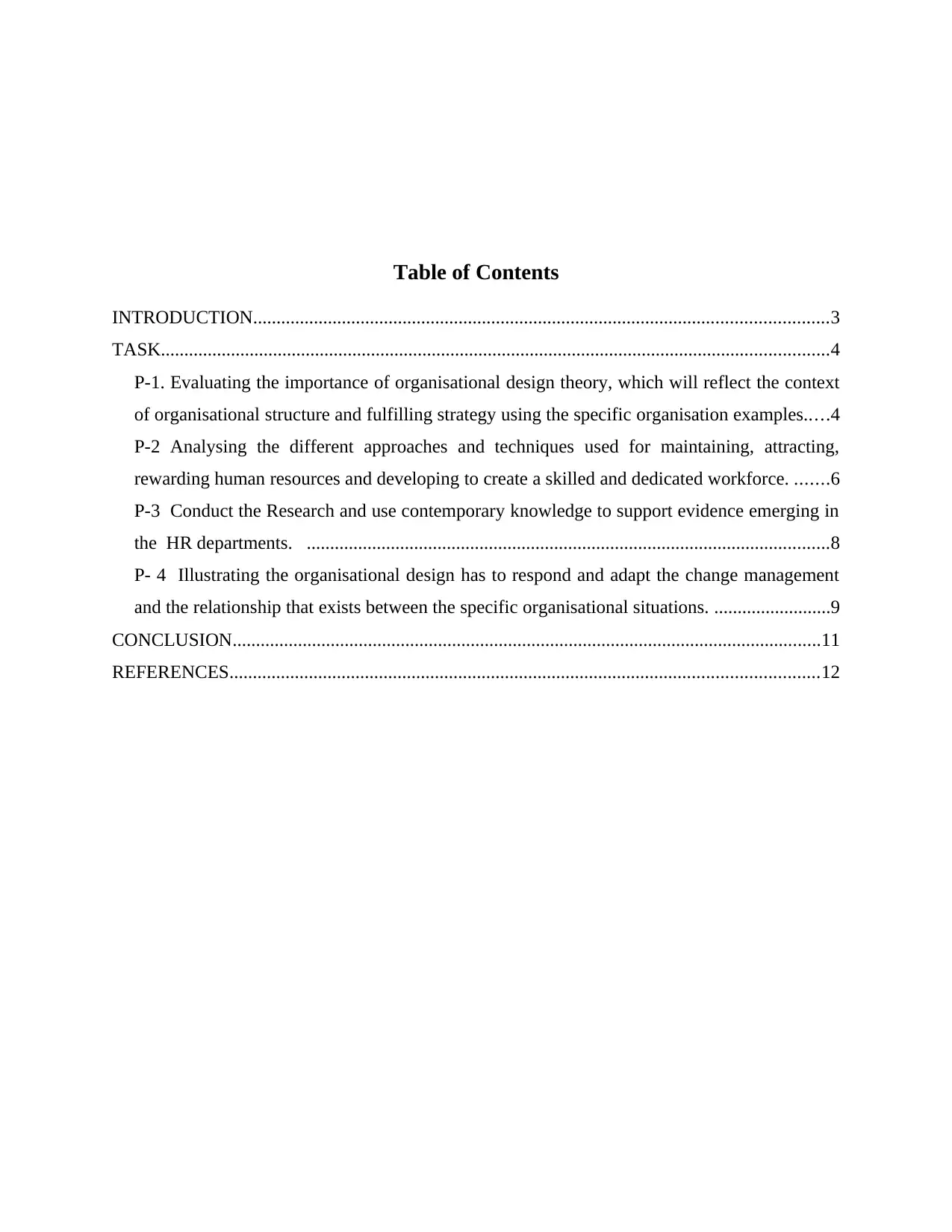
Table of Contents
INTRODUCTION...........................................................................................................................3
TASK...............................................................................................................................................4
P-1. Evaluating the importance of organisational design theory, which will reflect the context
of organisational structure and fulfilling strategy using the specific organisation examples.....4
P-2 Analysing the different approaches and techniques used for maintaining, attracting,
rewarding human resources and developing to create a skilled and dedicated workforce. .......6
P-3 Conduct the Research and use contemporary knowledge to support evidence emerging in
the HR departments. ................................................................................................................8
P- 4 Illustrating the organisational design has to respond and adapt the change management
and the relationship that exists between the specific organisational situations. .........................9
CONCLUSION..............................................................................................................................11
REFERENCES..............................................................................................................................12
INTRODUCTION...........................................................................................................................3
TASK...............................................................................................................................................4
P-1. Evaluating the importance of organisational design theory, which will reflect the context
of organisational structure and fulfilling strategy using the specific organisation examples.....4
P-2 Analysing the different approaches and techniques used for maintaining, attracting,
rewarding human resources and developing to create a skilled and dedicated workforce. .......6
P-3 Conduct the Research and use contemporary knowledge to support evidence emerging in
the HR departments. ................................................................................................................8
P- 4 Illustrating the organisational design has to respond and adapt the change management
and the relationship that exists between the specific organisational situations. .........................9
CONCLUSION..............................................................................................................................11
REFERENCES..............................................................................................................................12
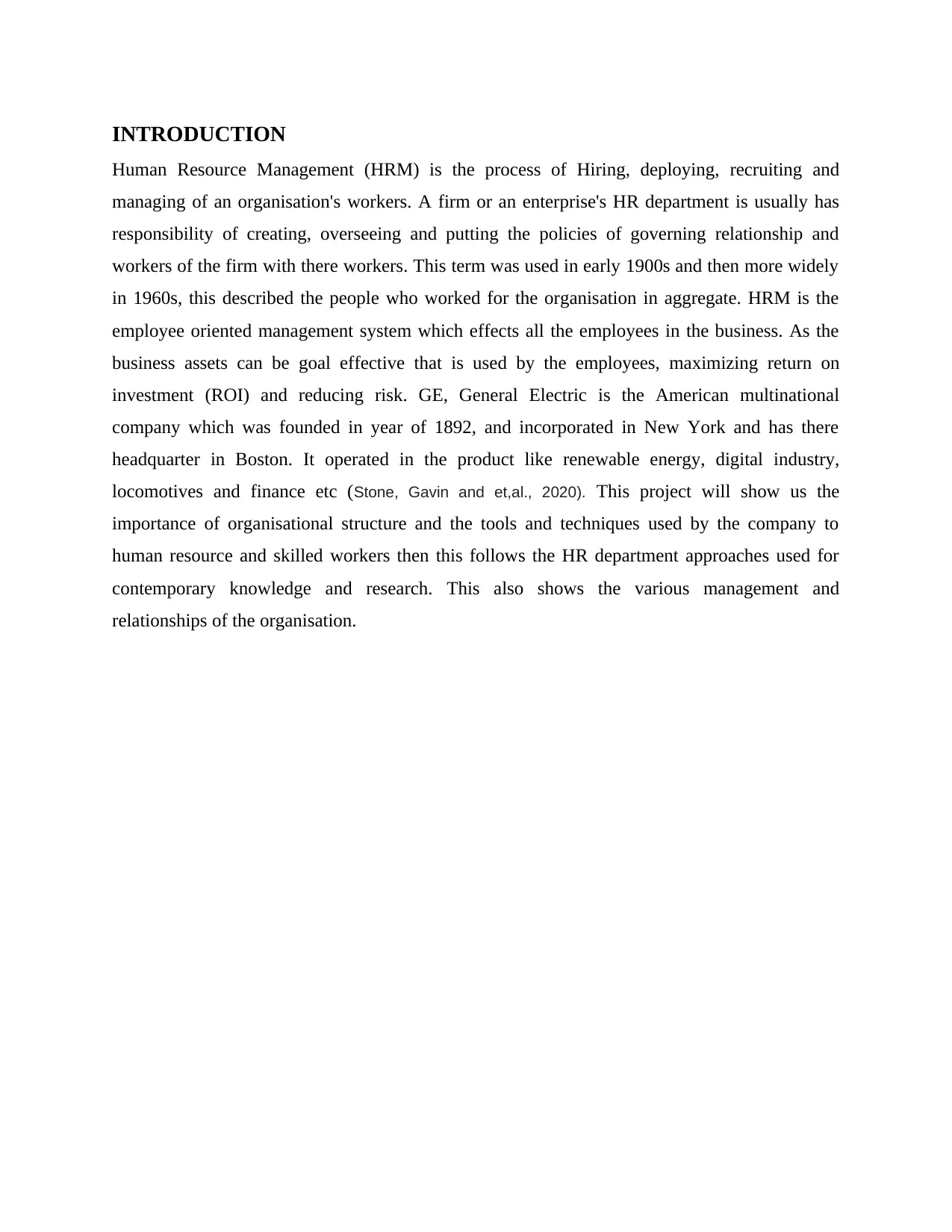
INTRODUCTION
Human Resource Management (HRM) is the process of Hiring, deploying, recruiting and
managing of an organisation's workers. A firm or an enterprise's HR department is usually has
responsibility of creating, overseeing and putting the policies of governing relationship and
workers of the firm with there workers. This term was used in early 1900s and then more widely
in 1960s, this described the people who worked for the organisation in aggregate. HRM is the
employee oriented management system which effects all the employees in the business. As the
business assets can be goal effective that is used by the employees, maximizing return on
investment (ROI) and reducing risk. GE, General Electric is the American multinational
company which was founded in year of 1892, and incorporated in New York and has there
headquarter in Boston. It operated in the product like renewable energy, digital industry,
locomotives and finance etc (Stone, Gavin and et,al., 2020). This project will show us the
importance of organisational structure and the tools and techniques used by the company to
human resource and skilled workers then this follows the HR department approaches used for
contemporary knowledge and research. This also shows the various management and
relationships of the organisation.
Human Resource Management (HRM) is the process of Hiring, deploying, recruiting and
managing of an organisation's workers. A firm or an enterprise's HR department is usually has
responsibility of creating, overseeing and putting the policies of governing relationship and
workers of the firm with there workers. This term was used in early 1900s and then more widely
in 1960s, this described the people who worked for the organisation in aggregate. HRM is the
employee oriented management system which effects all the employees in the business. As the
business assets can be goal effective that is used by the employees, maximizing return on
investment (ROI) and reducing risk. GE, General Electric is the American multinational
company which was founded in year of 1892, and incorporated in New York and has there
headquarter in Boston. It operated in the product like renewable energy, digital industry,
locomotives and finance etc (Stone, Gavin and et,al., 2020). This project will show us the
importance of organisational structure and the tools and techniques used by the company to
human resource and skilled workers then this follows the HR department approaches used for
contemporary knowledge and research. This also shows the various management and
relationships of the organisation.
⊘ This is a preview!⊘
Do you want full access?
Subscribe today to unlock all pages.

Trusted by 1+ million students worldwide
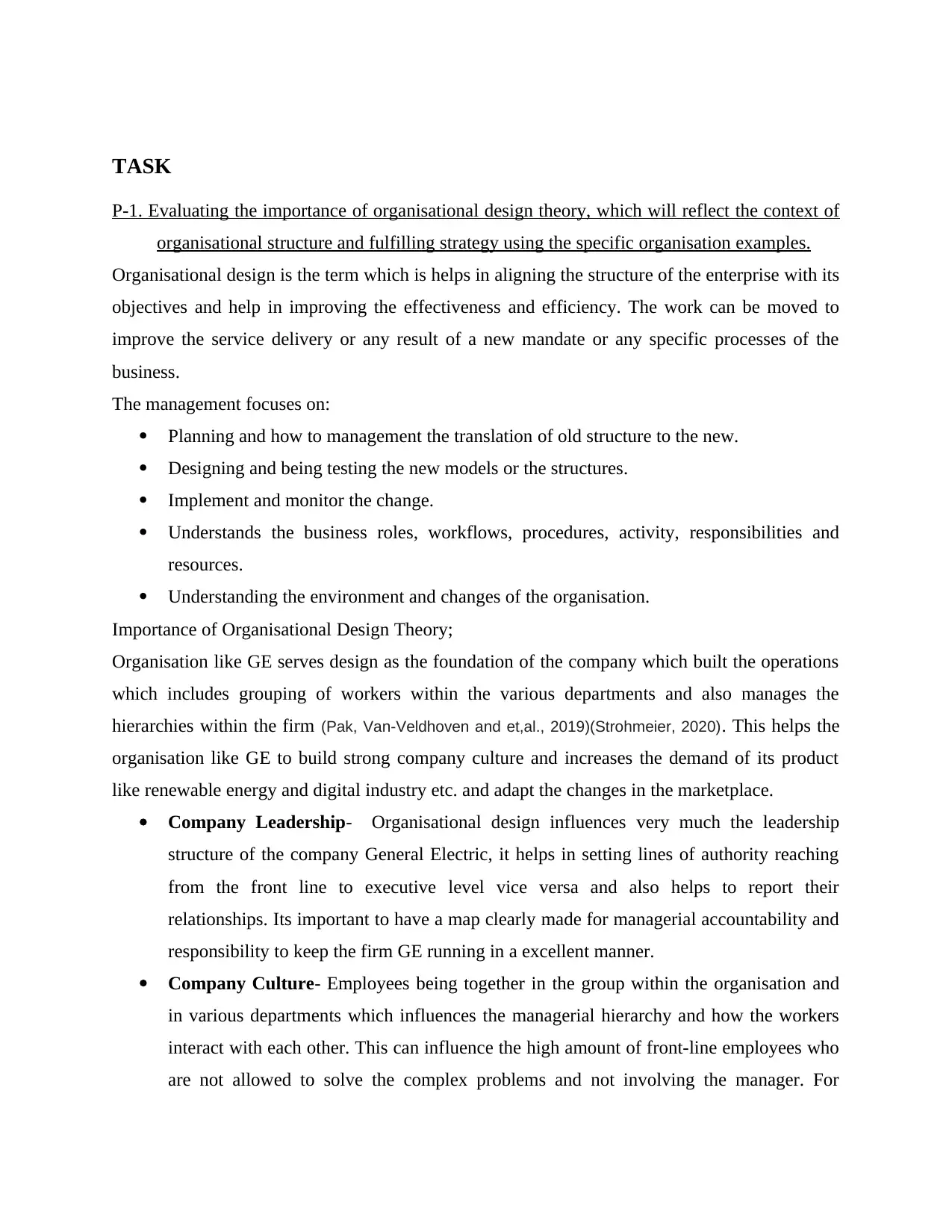
TASK
P-1. Evaluating the importance of organisational design theory, which will reflect the context of
organisational structure and fulfilling strategy using the specific organisation examples.
Organisational design is the term which is helps in aligning the structure of the enterprise with its
objectives and help in improving the effectiveness and efficiency. The work can be moved to
improve the service delivery or any result of a new mandate or any specific processes of the
business.
The management focuses on:
Planning and how to management the translation of old structure to the new.
Designing and being testing the new models or the structures.
Implement and monitor the change.
Understands the business roles, workflows, procedures, activity, responsibilities and
resources.
Understanding the environment and changes of the organisation.
Importance of Organisational Design Theory;
Organisation like GE serves design as the foundation of the company which built the operations
which includes grouping of workers within the various departments and also manages the
hierarchies within the firm (Pak, Van-Veldhoven and et,al., 2019)(Strohmeier, 2020). This helps the
organisation like GE to build strong company culture and increases the demand of its product
like renewable energy and digital industry etc. and adapt the changes in the marketplace.
Company Leadership- Organisational design influences very much the leadership
structure of the company General Electric, it helps in setting lines of authority reaching
from the front line to executive level vice versa and also helps to report their
relationships. Its important to have a map clearly made for managerial accountability and
responsibility to keep the firm GE running in a excellent manner.
Company Culture- Employees being together in the group within the organisation and
in various departments which influences the managerial hierarchy and how the workers
interact with each other. This can influence the high amount of front-line employees who
are not allowed to solve the complex problems and not involving the manager. For
P-1. Evaluating the importance of organisational design theory, which will reflect the context of
organisational structure and fulfilling strategy using the specific organisation examples.
Organisational design is the term which is helps in aligning the structure of the enterprise with its
objectives and help in improving the effectiveness and efficiency. The work can be moved to
improve the service delivery or any result of a new mandate or any specific processes of the
business.
The management focuses on:
Planning and how to management the translation of old structure to the new.
Designing and being testing the new models or the structures.
Implement and monitor the change.
Understands the business roles, workflows, procedures, activity, responsibilities and
resources.
Understanding the environment and changes of the organisation.
Importance of Organisational Design Theory;
Organisation like GE serves design as the foundation of the company which built the operations
which includes grouping of workers within the various departments and also manages the
hierarchies within the firm (Pak, Van-Veldhoven and et,al., 2019)(Strohmeier, 2020). This helps the
organisation like GE to build strong company culture and increases the demand of its product
like renewable energy and digital industry etc. and adapt the changes in the marketplace.
Company Leadership- Organisational design influences very much the leadership
structure of the company General Electric, it helps in setting lines of authority reaching
from the front line to executive level vice versa and also helps to report their
relationships. Its important to have a map clearly made for managerial accountability and
responsibility to keep the firm GE running in a excellent manner.
Company Culture- Employees being together in the group within the organisation and
in various departments which influences the managerial hierarchy and how the workers
interact with each other. This can influence the high amount of front-line employees who
are not allowed to solve the complex problems and not involving the manager. For
Paraphrase This Document
Need a fresh take? Get an instant paraphrase of this document with our AI Paraphraser
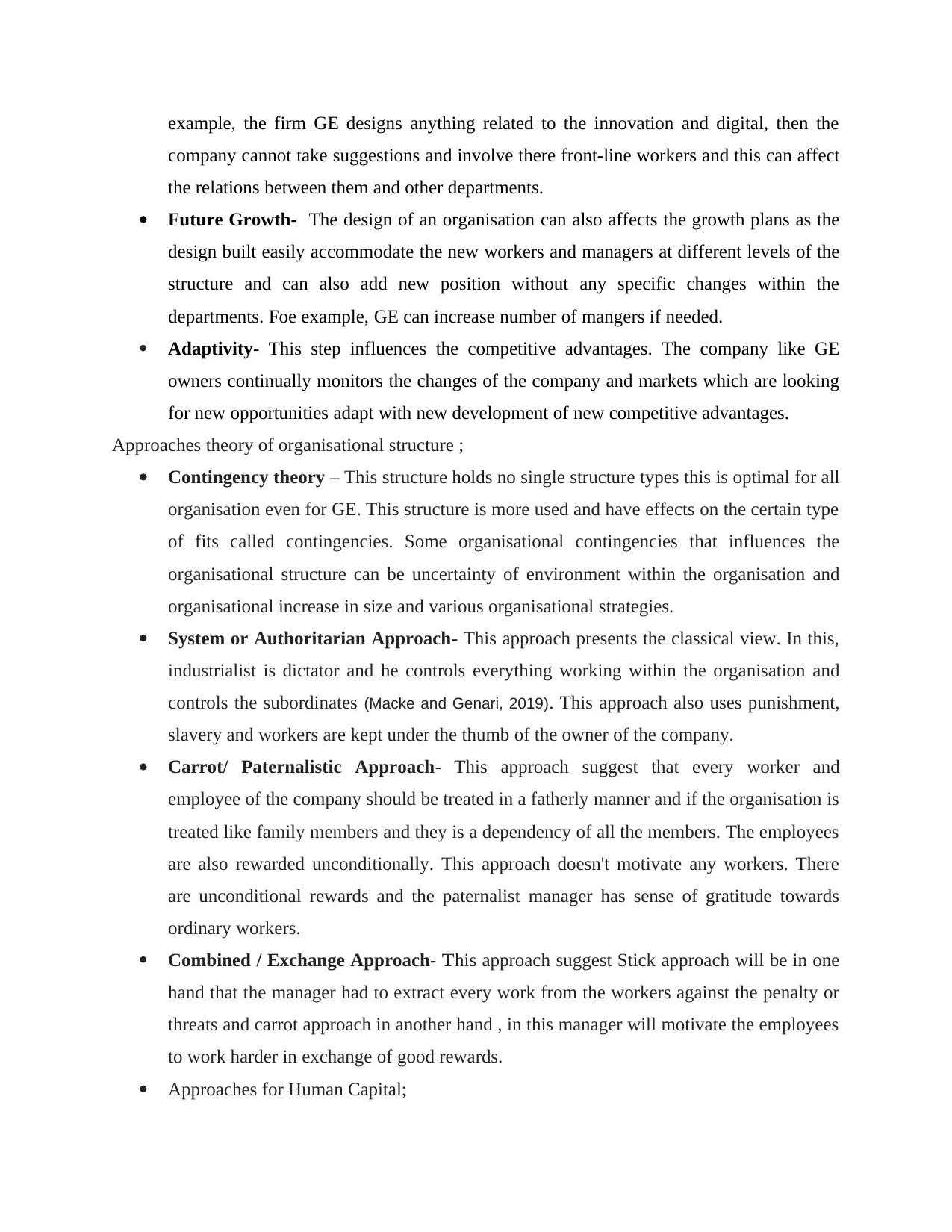
example, the firm GE designs anything related to the innovation and digital, then the
company cannot take suggestions and involve there front-line workers and this can affect
the relations between them and other departments.
Future Growth- The design of an organisation can also affects the growth plans as the
design built easily accommodate the new workers and managers at different levels of the
structure and can also add new position without any specific changes within the
departments. Foe example, GE can increase number of mangers if needed.
Adaptivity- This step influences the competitive advantages. The company like GE
owners continually monitors the changes of the company and markets which are looking
for new opportunities adapt with new development of new competitive advantages.
Approaches theory of organisational structure ;
Contingency theory – This structure holds no single structure types this is optimal for all
organisation even for GE. This structure is more used and have effects on the certain type
of fits called contingencies. Some organisational contingencies that influences the
organisational structure can be uncertainty of environment within the organisation and
organisational increase in size and various organisational strategies.
System or Authoritarian Approach- This approach presents the classical view. In this,
industrialist is dictator and he controls everything working within the organisation and
controls the subordinates (Macke and Genari, 2019). This approach also uses punishment,
slavery and workers are kept under the thumb of the owner of the company.
Carrot/ Paternalistic Approach- This approach suggest that every worker and
employee of the company should be treated in a fatherly manner and if the organisation is
treated like family members and they is a dependency of all the members. The employees
are also rewarded unconditionally. This approach doesn't motivate any workers. There
are unconditional rewards and the paternalist manager has sense of gratitude towards
ordinary workers.
Combined / Exchange Approach- This approach suggest Stick approach will be in one
hand that the manager had to extract every work from the workers against the penalty or
threats and carrot approach in another hand , in this manager will motivate the employees
to work harder in exchange of good rewards.
Approaches for Human Capital;
company cannot take suggestions and involve there front-line workers and this can affect
the relations between them and other departments.
Future Growth- The design of an organisation can also affects the growth plans as the
design built easily accommodate the new workers and managers at different levels of the
structure and can also add new position without any specific changes within the
departments. Foe example, GE can increase number of mangers if needed.
Adaptivity- This step influences the competitive advantages. The company like GE
owners continually monitors the changes of the company and markets which are looking
for new opportunities adapt with new development of new competitive advantages.
Approaches theory of organisational structure ;
Contingency theory – This structure holds no single structure types this is optimal for all
organisation even for GE. This structure is more used and have effects on the certain type
of fits called contingencies. Some organisational contingencies that influences the
organisational structure can be uncertainty of environment within the organisation and
organisational increase in size and various organisational strategies.
System or Authoritarian Approach- This approach presents the classical view. In this,
industrialist is dictator and he controls everything working within the organisation and
controls the subordinates (Macke and Genari, 2019). This approach also uses punishment,
slavery and workers are kept under the thumb of the owner of the company.
Carrot/ Paternalistic Approach- This approach suggest that every worker and
employee of the company should be treated in a fatherly manner and if the organisation is
treated like family members and they is a dependency of all the members. The employees
are also rewarded unconditionally. This approach doesn't motivate any workers. There
are unconditional rewards and the paternalist manager has sense of gratitude towards
ordinary workers.
Combined / Exchange Approach- This approach suggest Stick approach will be in one
hand that the manager had to extract every work from the workers against the penalty or
threats and carrot approach in another hand , in this manager will motivate the employees
to work harder in exchange of good rewards.
Approaches for Human Capital;
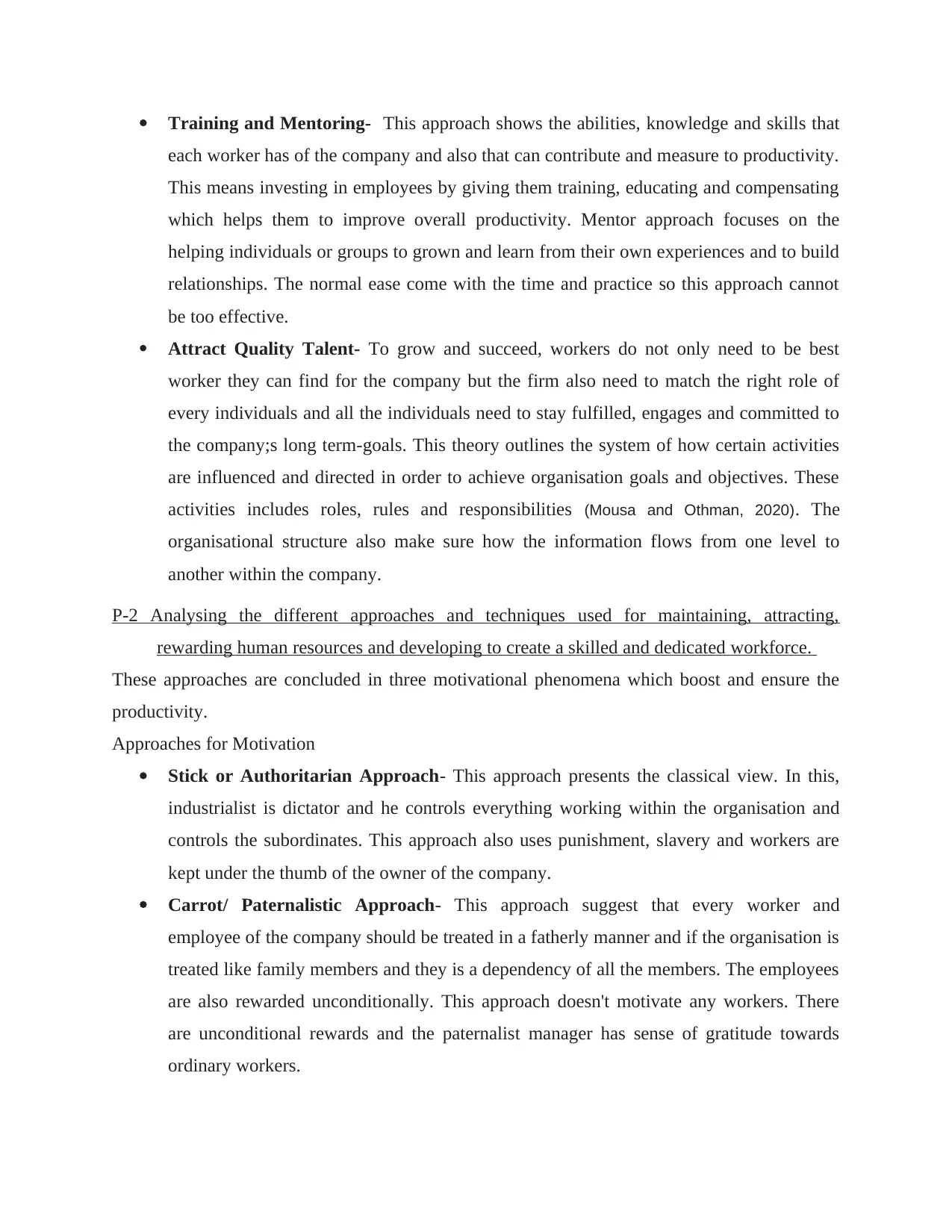
Training and Mentoring- This approach shows the abilities, knowledge and skills that
each worker has of the company and also that can contribute and measure to productivity.
This means investing in employees by giving them training, educating and compensating
which helps them to improve overall productivity. Mentor approach focuses on the
helping individuals or groups to grown and learn from their own experiences and to build
relationships. The normal ease come with the time and practice so this approach cannot
be too effective.
Attract Quality Talent- To grow and succeed, workers do not only need to be best
worker they can find for the company but the firm also need to match the right role of
every individuals and all the individuals need to stay fulfilled, engages and committed to
the company;s long term-goals. This theory outlines the system of how certain activities
are influenced and directed in order to achieve organisation goals and objectives. These
activities includes roles, rules and responsibilities (Mousa and Othman, 2020). The
organisational structure also make sure how the information flows from one level to
another within the company.
P-2 Analysing the different approaches and techniques used for maintaining, attracting,
rewarding human resources and developing to create a skilled and dedicated workforce.
These approaches are concluded in three motivational phenomena which boost and ensure the
productivity.
Approaches for Motivation
Stick or Authoritarian Approach- This approach presents the classical view. In this,
industrialist is dictator and he controls everything working within the organisation and
controls the subordinates. This approach also uses punishment, slavery and workers are
kept under the thumb of the owner of the company.
Carrot/ Paternalistic Approach- This approach suggest that every worker and
employee of the company should be treated in a fatherly manner and if the organisation is
treated like family members and they is a dependency of all the members. The employees
are also rewarded unconditionally. This approach doesn't motivate any workers. There
are unconditional rewards and the paternalist manager has sense of gratitude towards
ordinary workers.
each worker has of the company and also that can contribute and measure to productivity.
This means investing in employees by giving them training, educating and compensating
which helps them to improve overall productivity. Mentor approach focuses on the
helping individuals or groups to grown and learn from their own experiences and to build
relationships. The normal ease come with the time and practice so this approach cannot
be too effective.
Attract Quality Talent- To grow and succeed, workers do not only need to be best
worker they can find for the company but the firm also need to match the right role of
every individuals and all the individuals need to stay fulfilled, engages and committed to
the company;s long term-goals. This theory outlines the system of how certain activities
are influenced and directed in order to achieve organisation goals and objectives. These
activities includes roles, rules and responsibilities (Mousa and Othman, 2020). The
organisational structure also make sure how the information flows from one level to
another within the company.
P-2 Analysing the different approaches and techniques used for maintaining, attracting,
rewarding human resources and developing to create a skilled and dedicated workforce.
These approaches are concluded in three motivational phenomena which boost and ensure the
productivity.
Approaches for Motivation
Stick or Authoritarian Approach- This approach presents the classical view. In this,
industrialist is dictator and he controls everything working within the organisation and
controls the subordinates. This approach also uses punishment, slavery and workers are
kept under the thumb of the owner of the company.
Carrot/ Paternalistic Approach- This approach suggest that every worker and
employee of the company should be treated in a fatherly manner and if the organisation is
treated like family members and they is a dependency of all the members. The employees
are also rewarded unconditionally. This approach doesn't motivate any workers. There
are unconditional rewards and the paternalist manager has sense of gratitude towards
ordinary workers.
⊘ This is a preview!⊘
Do you want full access?
Subscribe today to unlock all pages.

Trusted by 1+ million students worldwide
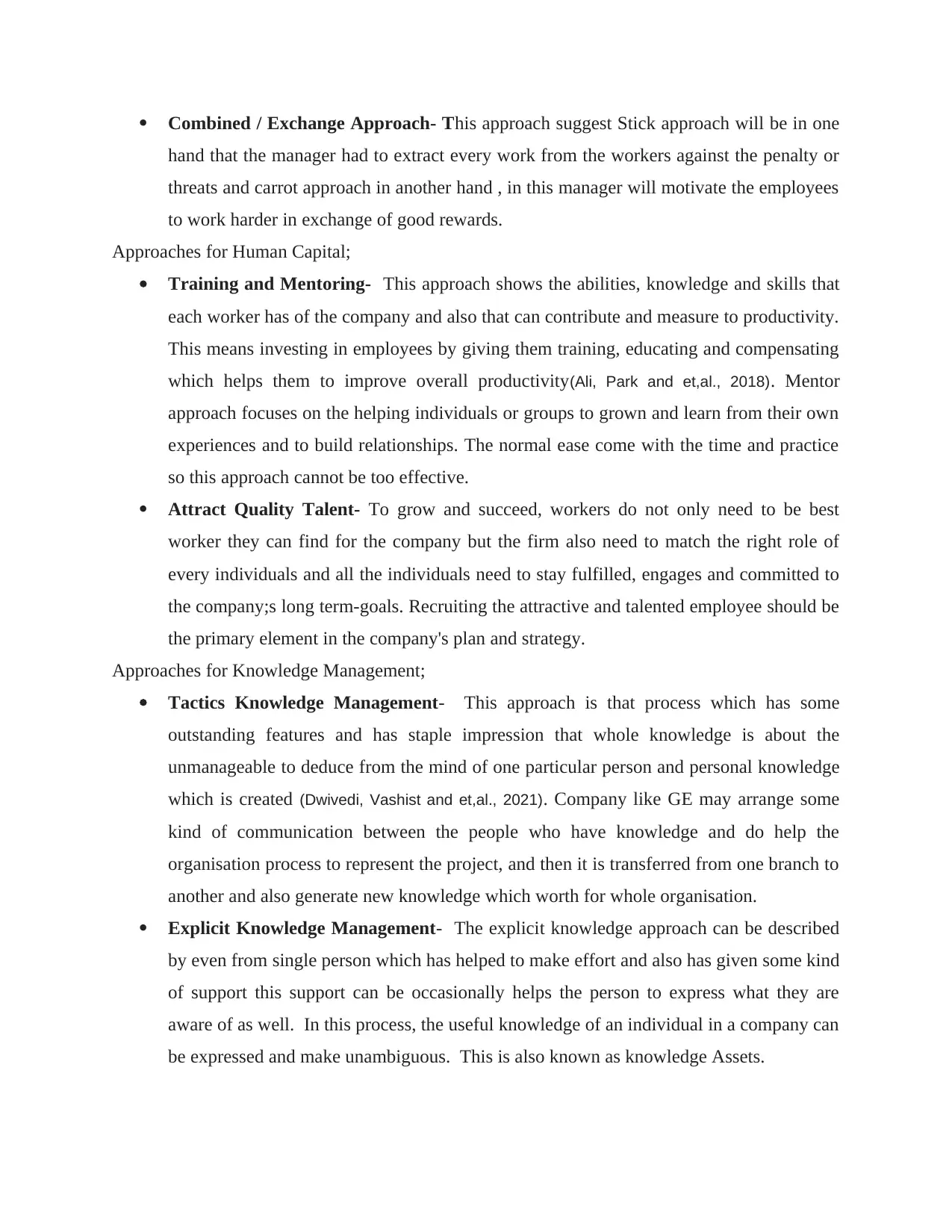
Combined / Exchange Approach- This approach suggest Stick approach will be in one
hand that the manager had to extract every work from the workers against the penalty or
threats and carrot approach in another hand , in this manager will motivate the employees
to work harder in exchange of good rewards.
Approaches for Human Capital;
Training and Mentoring- This approach shows the abilities, knowledge and skills that
each worker has of the company and also that can contribute and measure to productivity.
This means investing in employees by giving them training, educating and compensating
which helps them to improve overall productivity(Ali, Park and et,al., 2018). Mentor
approach focuses on the helping individuals or groups to grown and learn from their own
experiences and to build relationships. The normal ease come with the time and practice
so this approach cannot be too effective.
Attract Quality Talent- To grow and succeed, workers do not only need to be best
worker they can find for the company but the firm also need to match the right role of
every individuals and all the individuals need to stay fulfilled, engages and committed to
the company;s long term-goals. Recruiting the attractive and talented employee should be
the primary element in the company's plan and strategy.
Approaches for Knowledge Management;
Tactics Knowledge Management- This approach is that process which has some
outstanding features and has staple impression that whole knowledge is about the
unmanageable to deduce from the mind of one particular person and personal knowledge
which is created (Dwivedi, Vashist and et,al., 2021). Company like GE may arrange some
kind of communication between the people who have knowledge and do help the
organisation process to represent the project, and then it is transferred from one branch to
another and also generate new knowledge which worth for whole organisation.
Explicit Knowledge Management- The explicit knowledge approach can be described
by even from single person which has helped to make effort and also has given some kind
of support this support can be occasionally helps the person to express what they are
aware of as well. In this process, the useful knowledge of an individual in a company can
be expressed and make unambiguous. This is also known as knowledge Assets.
hand that the manager had to extract every work from the workers against the penalty or
threats and carrot approach in another hand , in this manager will motivate the employees
to work harder in exchange of good rewards.
Approaches for Human Capital;
Training and Mentoring- This approach shows the abilities, knowledge and skills that
each worker has of the company and also that can contribute and measure to productivity.
This means investing in employees by giving them training, educating and compensating
which helps them to improve overall productivity(Ali, Park and et,al., 2018). Mentor
approach focuses on the helping individuals or groups to grown and learn from their own
experiences and to build relationships. The normal ease come with the time and practice
so this approach cannot be too effective.
Attract Quality Talent- To grow and succeed, workers do not only need to be best
worker they can find for the company but the firm also need to match the right role of
every individuals and all the individuals need to stay fulfilled, engages and committed to
the company;s long term-goals. Recruiting the attractive and talented employee should be
the primary element in the company's plan and strategy.
Approaches for Knowledge Management;
Tactics Knowledge Management- This approach is that process which has some
outstanding features and has staple impression that whole knowledge is about the
unmanageable to deduce from the mind of one particular person and personal knowledge
which is created (Dwivedi, Vashist and et,al., 2021). Company like GE may arrange some
kind of communication between the people who have knowledge and do help the
organisation process to represent the project, and then it is transferred from one branch to
another and also generate new knowledge which worth for whole organisation.
Explicit Knowledge Management- The explicit knowledge approach can be described
by even from single person which has helped to make effort and also has given some kind
of support this support can be occasionally helps the person to express what they are
aware of as well. In this process, the useful knowledge of an individual in a company can
be expressed and make unambiguous. This is also known as knowledge Assets.
Paraphrase This Document
Need a fresh take? Get an instant paraphrase of this document with our AI Paraphraser
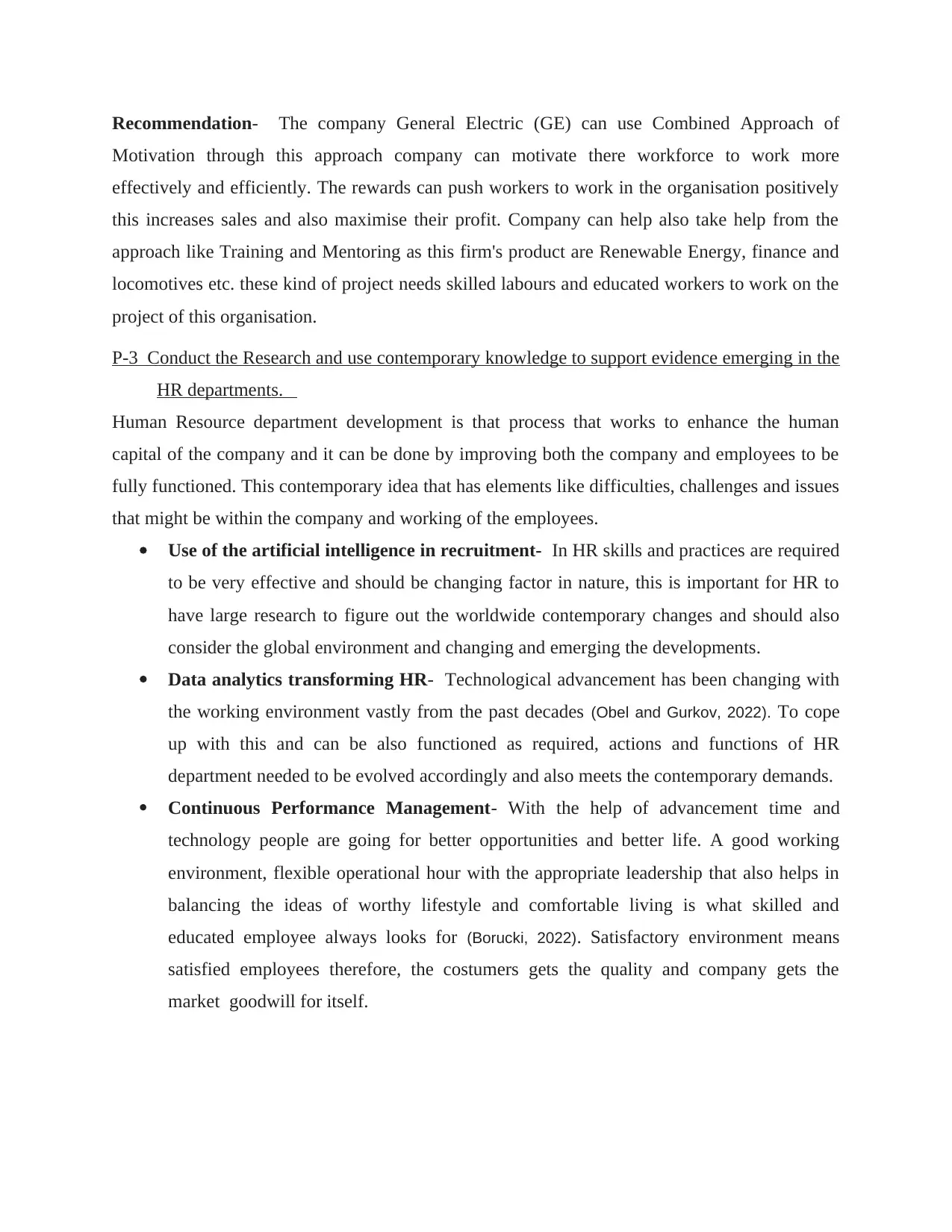
Recommendation- The company General Electric (GE) can use Combined Approach of
Motivation through this approach company can motivate there workforce to work more
effectively and efficiently. The rewards can push workers to work in the organisation positively
this increases sales and also maximise their profit. Company can help also take help from the
approach like Training and Mentoring as this firm's product are Renewable Energy, finance and
locomotives etc. these kind of project needs skilled labours and educated workers to work on the
project of this organisation.
P-3 Conduct the Research and use contemporary knowledge to support evidence emerging in the
HR departments.
Human Resource department development is that process that works to enhance the human
capital of the company and it can be done by improving both the company and employees to be
fully functioned. This contemporary idea that has elements like difficulties, challenges and issues
that might be within the company and working of the employees.
Use of the artificial intelligence in recruitment- In HR skills and practices are required
to be very effective and should be changing factor in nature, this is important for HR to
have large research to figure out the worldwide contemporary changes and should also
consider the global environment and changing and emerging the developments.
Data analytics transforming HR- Technological advancement has been changing with
the working environment vastly from the past decades (Obel and Gurkov, 2022). To cope
up with this and can be also functioned as required, actions and functions of HR
department needed to be evolved accordingly and also meets the contemporary demands.
Continuous Performance Management- With the help of advancement time and
technology people are going for better opportunities and better life. A good working
environment, flexible operational hour with the appropriate leadership that also helps in
balancing the ideas of worthy lifestyle and comfortable living is what skilled and
educated employee always looks for (Borucki, 2022). Satisfactory environment means
satisfied employees therefore, the costumers gets the quality and company gets the
market goodwill for itself.
Motivation through this approach company can motivate there workforce to work more
effectively and efficiently. The rewards can push workers to work in the organisation positively
this increases sales and also maximise their profit. Company can help also take help from the
approach like Training and Mentoring as this firm's product are Renewable Energy, finance and
locomotives etc. these kind of project needs skilled labours and educated workers to work on the
project of this organisation.
P-3 Conduct the Research and use contemporary knowledge to support evidence emerging in the
HR departments.
Human Resource department development is that process that works to enhance the human
capital of the company and it can be done by improving both the company and employees to be
fully functioned. This contemporary idea that has elements like difficulties, challenges and issues
that might be within the company and working of the employees.
Use of the artificial intelligence in recruitment- In HR skills and practices are required
to be very effective and should be changing factor in nature, this is important for HR to
have large research to figure out the worldwide contemporary changes and should also
consider the global environment and changing and emerging the developments.
Data analytics transforming HR- Technological advancement has been changing with
the working environment vastly from the past decades (Obel and Gurkov, 2022). To cope
up with this and can be also functioned as required, actions and functions of HR
department needed to be evolved accordingly and also meets the contemporary demands.
Continuous Performance Management- With the help of advancement time and
technology people are going for better opportunities and better life. A good working
environment, flexible operational hour with the appropriate leadership that also helps in
balancing the ideas of worthy lifestyle and comfortable living is what skilled and
educated employee always looks for (Borucki, 2022). Satisfactory environment means
satisfied employees therefore, the costumers gets the quality and company gets the
market goodwill for itself.
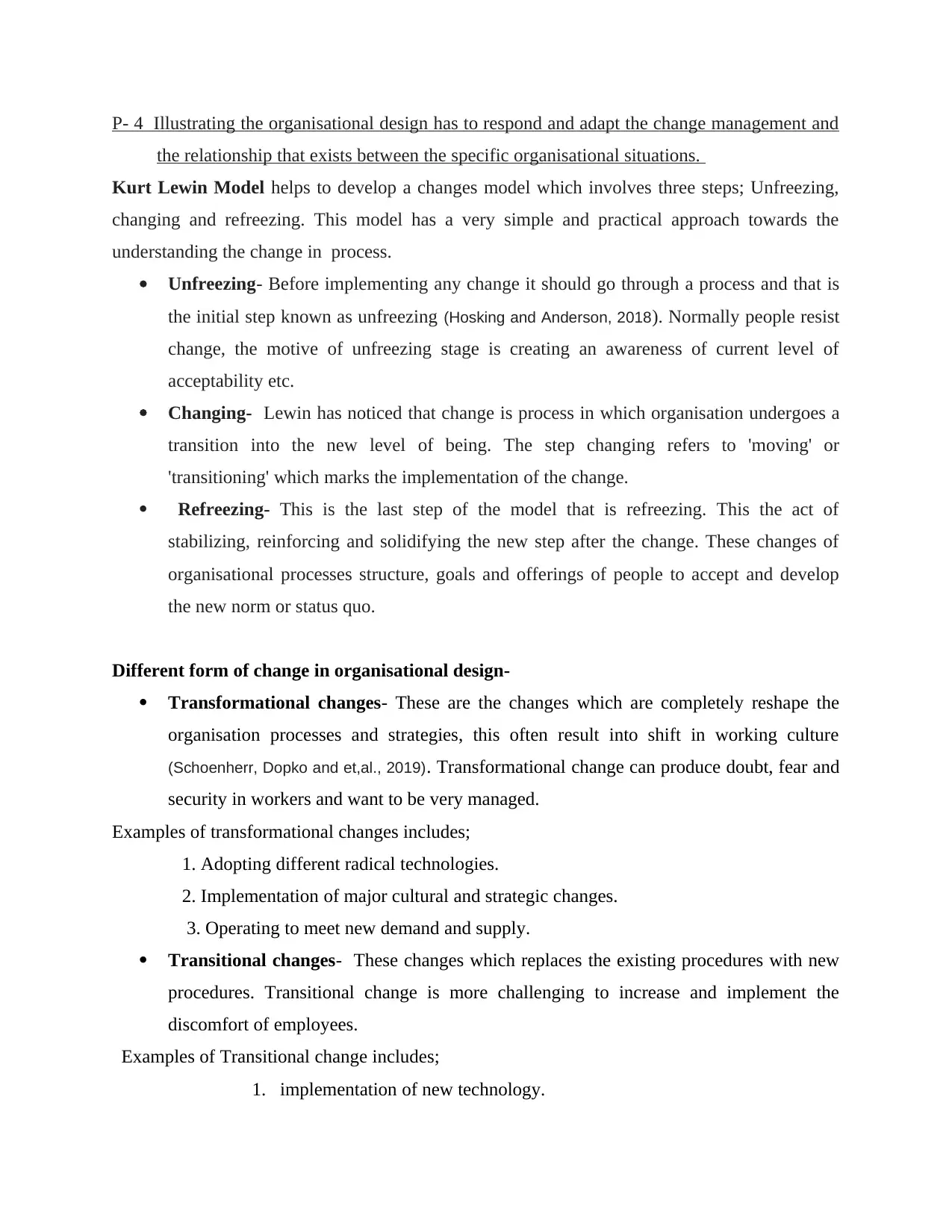
P- 4 Illustrating the organisational design has to respond and adapt the change management and
the relationship that exists between the specific organisational situations.
Kurt Lewin Model helps to develop a changes model which involves three steps; Unfreezing,
changing and refreezing. This model has a very simple and practical approach towards the
understanding the change in process.
Unfreezing- Before implementing any change it should go through a process and that is
the initial step known as unfreezing (Hosking and Anderson, 2018). Normally people resist
change, the motive of unfreezing stage is creating an awareness of current level of
acceptability etc.
Changing- Lewin has noticed that change is process in which organisation undergoes a
transition into the new level of being. The step changing refers to 'moving' or
'transitioning' which marks the implementation of the change.
Refreezing- This is the last step of the model that is refreezing. This the act of
stabilizing, reinforcing and solidifying the new step after the change. These changes of
organisational processes structure, goals and offerings of people to accept and develop
the new norm or status quo.
Different form of change in organisational design-
Transformational changes- These are the changes which are completely reshape the
organisation processes and strategies, this often result into shift in working culture
(Schoenherr, Dopko and et,al., 2019). Transformational change can produce doubt, fear and
security in workers and want to be very managed.
Examples of transformational changes includes;
1. Adopting different radical technologies.
2. Implementation of major cultural and strategic changes.
3. Operating to meet new demand and supply.
Transitional changes- These changes which replaces the existing procedures with new
procedures. Transitional change is more challenging to increase and implement the
discomfort of employees.
Examples of Transitional change includes;
1. implementation of new technology.
the relationship that exists between the specific organisational situations.
Kurt Lewin Model helps to develop a changes model which involves three steps; Unfreezing,
changing and refreezing. This model has a very simple and practical approach towards the
understanding the change in process.
Unfreezing- Before implementing any change it should go through a process and that is
the initial step known as unfreezing (Hosking and Anderson, 2018). Normally people resist
change, the motive of unfreezing stage is creating an awareness of current level of
acceptability etc.
Changing- Lewin has noticed that change is process in which organisation undergoes a
transition into the new level of being. The step changing refers to 'moving' or
'transitioning' which marks the implementation of the change.
Refreezing- This is the last step of the model that is refreezing. This the act of
stabilizing, reinforcing and solidifying the new step after the change. These changes of
organisational processes structure, goals and offerings of people to accept and develop
the new norm or status quo.
Different form of change in organisational design-
Transformational changes- These are the changes which are completely reshape the
organisation processes and strategies, this often result into shift in working culture
(Schoenherr, Dopko and et,al., 2019). Transformational change can produce doubt, fear and
security in workers and want to be very managed.
Examples of transformational changes includes;
1. Adopting different radical technologies.
2. Implementation of major cultural and strategic changes.
3. Operating to meet new demand and supply.
Transitional changes- These changes which replaces the existing procedures with new
procedures. Transitional change is more challenging to increase and implement the
discomfort of employees.
Examples of Transitional change includes;
1. implementation of new technology.
⊘ This is a preview!⊘
Do you want full access?
Subscribe today to unlock all pages.

Trusted by 1+ million students worldwide
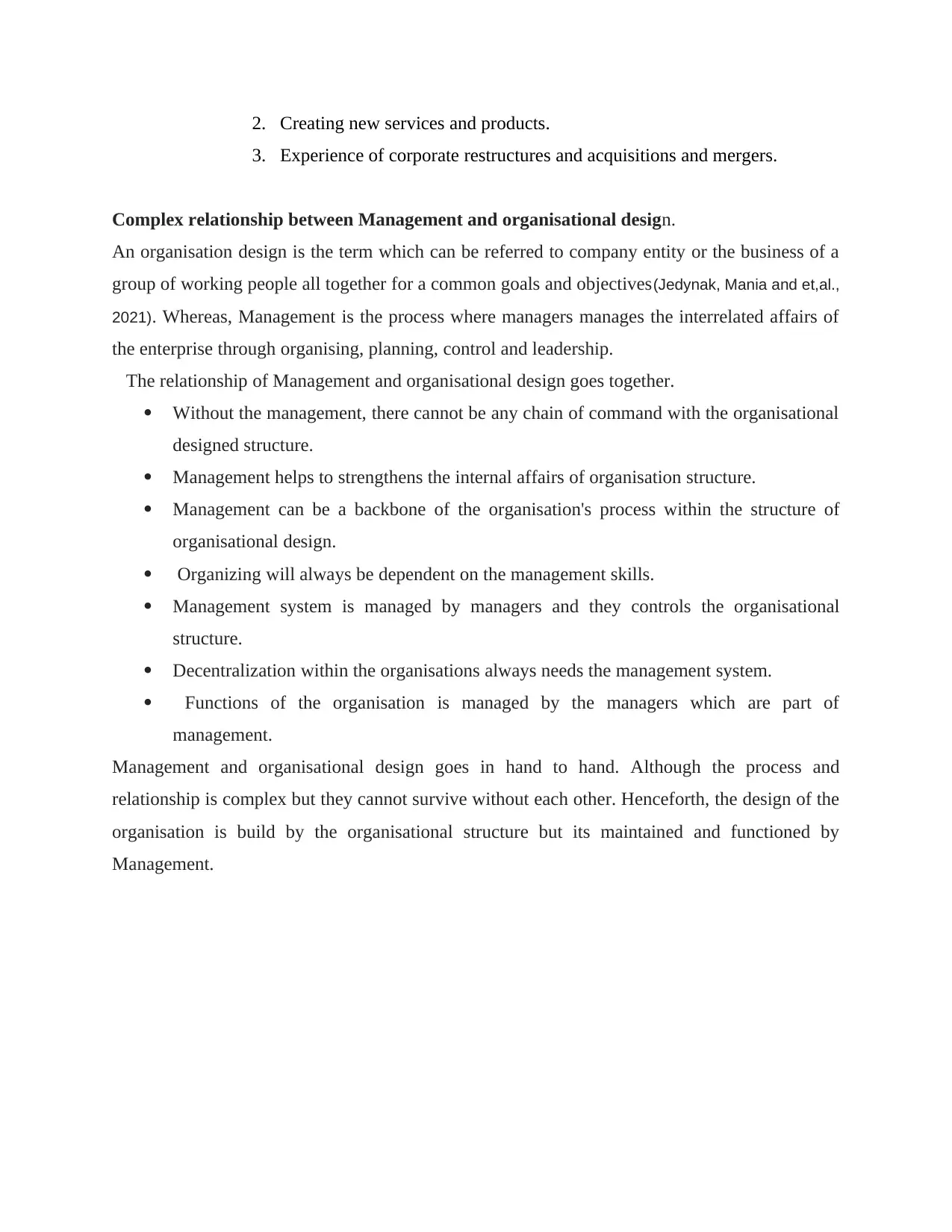
2. Creating new services and products.
3. Experience of corporate restructures and acquisitions and mergers.
Complex relationship between Management and organisational design.
An organisation design is the term which can be referred to company entity or the business of a
group of working people all together for a common goals and objectives(Jedynak, Mania and et,al.,
2021). Whereas, Management is the process where managers manages the interrelated affairs of
the enterprise through organising, planning, control and leadership.
The relationship of Management and organisational design goes together.
Without the management, there cannot be any chain of command with the organisational
designed structure.
Management helps to strengthens the internal affairs of organisation structure.
Management can be a backbone of the organisation's process within the structure of
organisational design.
Organizing will always be dependent on the management skills.
Management system is managed by managers and they controls the organisational
structure.
Decentralization within the organisations always needs the management system.
Functions of the organisation is managed by the managers which are part of
management.
Management and organisational design goes in hand to hand. Although the process and
relationship is complex but they cannot survive without each other. Henceforth, the design of the
organisation is build by the organisational structure but its maintained and functioned by
Management.
3. Experience of corporate restructures and acquisitions and mergers.
Complex relationship between Management and organisational design.
An organisation design is the term which can be referred to company entity or the business of a
group of working people all together for a common goals and objectives(Jedynak, Mania and et,al.,
2021). Whereas, Management is the process where managers manages the interrelated affairs of
the enterprise through organising, planning, control and leadership.
The relationship of Management and organisational design goes together.
Without the management, there cannot be any chain of command with the organisational
designed structure.
Management helps to strengthens the internal affairs of organisation structure.
Management can be a backbone of the organisation's process within the structure of
organisational design.
Organizing will always be dependent on the management skills.
Management system is managed by managers and they controls the organisational
structure.
Decentralization within the organisations always needs the management system.
Functions of the organisation is managed by the managers which are part of
management.
Management and organisational design goes in hand to hand. Although the process and
relationship is complex but they cannot survive without each other. Henceforth, the design of the
organisation is build by the organisational structure but its maintained and functioned by
Management.
Paraphrase This Document
Need a fresh take? Get an instant paraphrase of this document with our AI Paraphraser
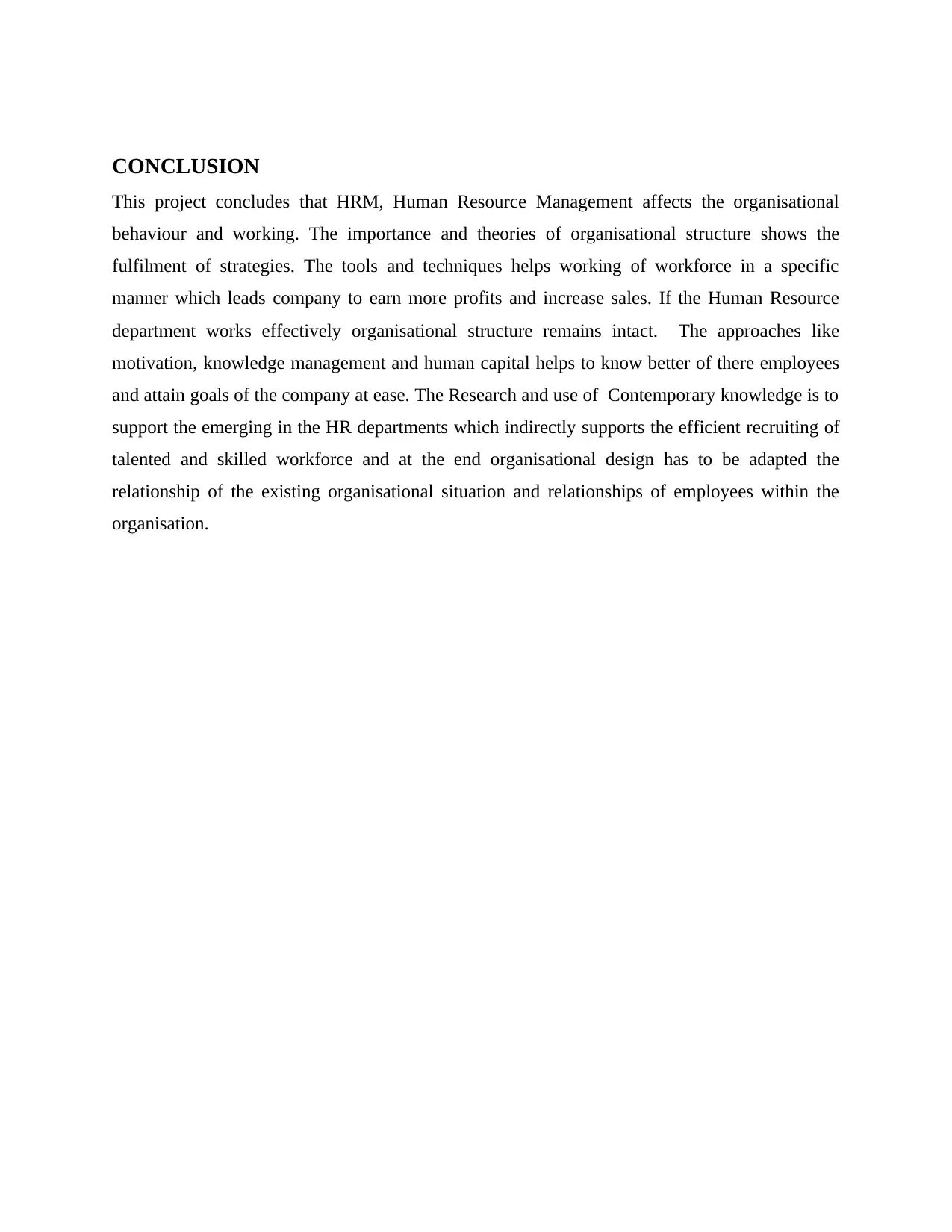
CONCLUSION
This project concludes that HRM, Human Resource Management affects the organisational
behaviour and working. The importance and theories of organisational structure shows the
fulfilment of strategies. The tools and techniques helps working of workforce in a specific
manner which leads company to earn more profits and increase sales. If the Human Resource
department works effectively organisational structure remains intact. The approaches like
motivation, knowledge management and human capital helps to know better of there employees
and attain goals of the company at ease. The Research and use of Contemporary knowledge is to
support the emerging in the HR departments which indirectly supports the efficient recruiting of
talented and skilled workforce and at the end organisational design has to be adapted the
relationship of the existing organisational situation and relationships of employees within the
organisation.
This project concludes that HRM, Human Resource Management affects the organisational
behaviour and working. The importance and theories of organisational structure shows the
fulfilment of strategies. The tools and techniques helps working of workforce in a specific
manner which leads company to earn more profits and increase sales. If the Human Resource
department works effectively organisational structure remains intact. The approaches like
motivation, knowledge management and human capital helps to know better of there employees
and attain goals of the company at ease. The Research and use of Contemporary knowledge is to
support the emerging in the HR departments which indirectly supports the efficient recruiting of
talented and skilled workforce and at the end organisational design has to be adapted the
relationship of the existing organisational situation and relationships of employees within the
organisation.
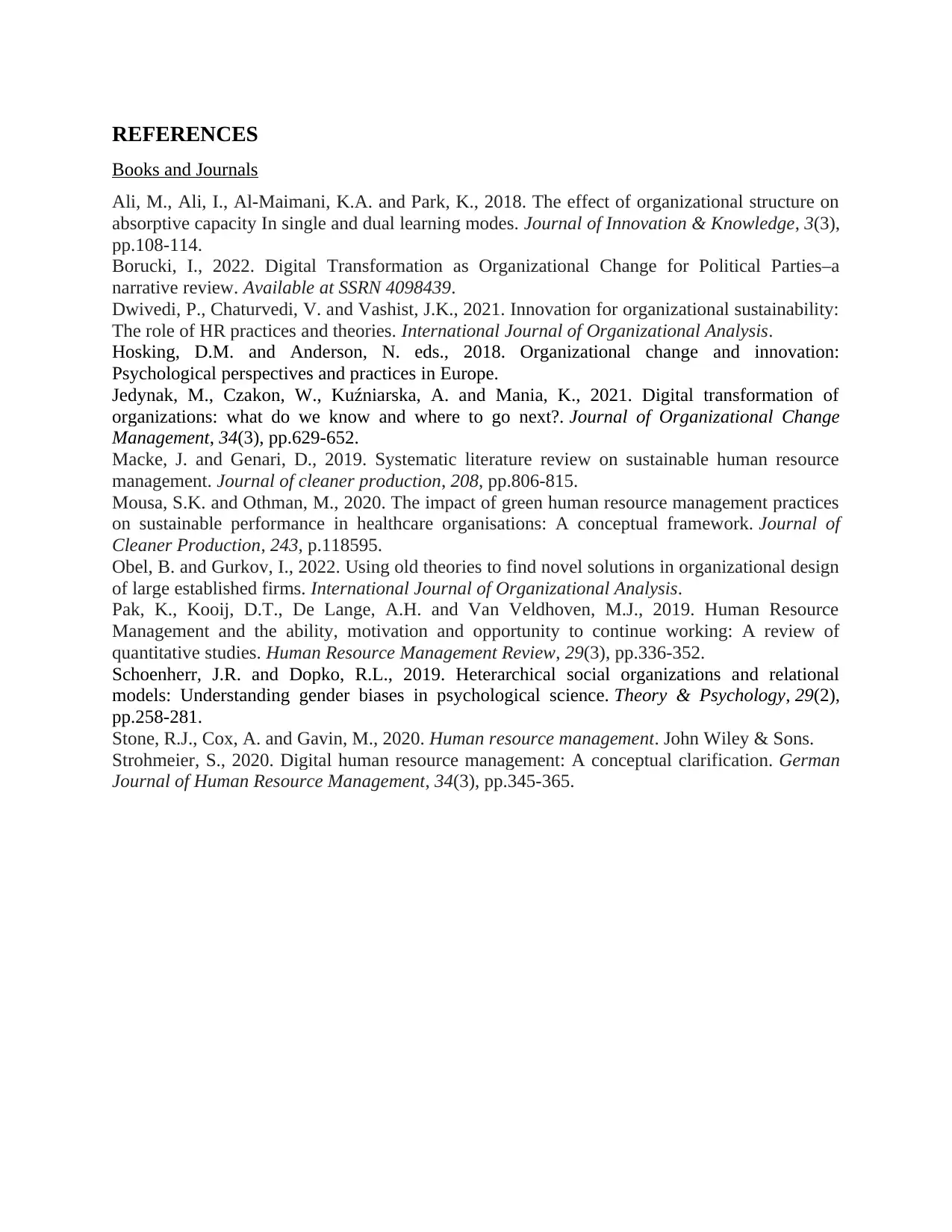
REFERENCES
Books and Journals
Ali, M., Ali, I., Al-Maimani, K.A. and Park, K., 2018. The effect of organizational structure on
absorptive capacity In single and dual learning modes. Journal of Innovation & Knowledge, 3(3),
pp.108-114.
Borucki, I., 2022. Digital Transformation as Organizational Change for Political Parties–a
narrative review. Available at SSRN 4098439.
Dwivedi, P., Chaturvedi, V. and Vashist, J.K., 2021. Innovation for organizational sustainability:
The role of HR practices and theories. International Journal of Organizational Analysis.
Hosking, D.M. and Anderson, N. eds., 2018. Organizational change and innovation:
Psychological perspectives and practices in Europe.
Jedynak, M., Czakon, W., Kuźniarska, A. and Mania, K., 2021. Digital transformation of
organizations: what do we know and where to go next?. Journal of Organizational Change
Management, 34(3), pp.629-652.
Macke, J. and Genari, D., 2019. Systematic literature review on sustainable human resource
management. Journal of cleaner production, 208, pp.806-815.
Mousa, S.K. and Othman, M., 2020. The impact of green human resource management practices
on sustainable performance in healthcare organisations: A conceptual framework. Journal of
Cleaner Production, 243, p.118595.
Obel, B. and Gurkov, I., 2022. Using old theories to find novel solutions in organizational design
of large established firms. International Journal of Organizational Analysis.
Pak, K., Kooij, D.T., De Lange, A.H. and Van Veldhoven, M.J., 2019. Human Resource
Management and the ability, motivation and opportunity to continue working: A review of
quantitative studies. Human Resource Management Review, 29(3), pp.336-352.
Schoenherr, J.R. and Dopko, R.L., 2019. Heterarchical social organizations and relational
models: Understanding gender biases in psychological science. Theory & Psychology, 29(2),
pp.258-281.
Stone, R.J., Cox, A. and Gavin, M., 2020. Human resource management. John Wiley & Sons.
Strohmeier, S., 2020. Digital human resource management: A conceptual clarification. German
Journal of Human Resource Management, 34(3), pp.345-365.
Books and Journals
Ali, M., Ali, I., Al-Maimani, K.A. and Park, K., 2018. The effect of organizational structure on
absorptive capacity In single and dual learning modes. Journal of Innovation & Knowledge, 3(3),
pp.108-114.
Borucki, I., 2022. Digital Transformation as Organizational Change for Political Parties–a
narrative review. Available at SSRN 4098439.
Dwivedi, P., Chaturvedi, V. and Vashist, J.K., 2021. Innovation for organizational sustainability:
The role of HR practices and theories. International Journal of Organizational Analysis.
Hosking, D.M. and Anderson, N. eds., 2018. Organizational change and innovation:
Psychological perspectives and practices in Europe.
Jedynak, M., Czakon, W., Kuźniarska, A. and Mania, K., 2021. Digital transformation of
organizations: what do we know and where to go next?. Journal of Organizational Change
Management, 34(3), pp.629-652.
Macke, J. and Genari, D., 2019. Systematic literature review on sustainable human resource
management. Journal of cleaner production, 208, pp.806-815.
Mousa, S.K. and Othman, M., 2020. The impact of green human resource management practices
on sustainable performance in healthcare organisations: A conceptual framework. Journal of
Cleaner Production, 243, p.118595.
Obel, B. and Gurkov, I., 2022. Using old theories to find novel solutions in organizational design
of large established firms. International Journal of Organizational Analysis.
Pak, K., Kooij, D.T., De Lange, A.H. and Van Veldhoven, M.J., 2019. Human Resource
Management and the ability, motivation and opportunity to continue working: A review of
quantitative studies. Human Resource Management Review, 29(3), pp.336-352.
Schoenherr, J.R. and Dopko, R.L., 2019. Heterarchical social organizations and relational
models: Understanding gender biases in psychological science. Theory & Psychology, 29(2),
pp.258-281.
Stone, R.J., Cox, A. and Gavin, M., 2020. Human resource management. John Wiley & Sons.
Strohmeier, S., 2020. Digital human resource management: A conceptual clarification. German
Journal of Human Resource Management, 34(3), pp.345-365.
⊘ This is a preview!⊘
Do you want full access?
Subscribe today to unlock all pages.

Trusted by 1+ million students worldwide
1 out of 12
Related Documents
Your All-in-One AI-Powered Toolkit for Academic Success.
+13062052269
info@desklib.com
Available 24*7 on WhatsApp / Email
![[object Object]](/_next/static/media/star-bottom.7253800d.svg)
Unlock your academic potential
Copyright © 2020–2025 A2Z Services. All Rights Reserved. Developed and managed by ZUCOL.





